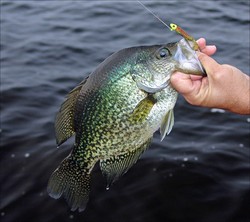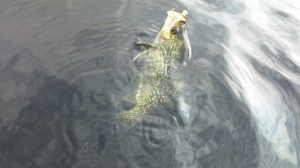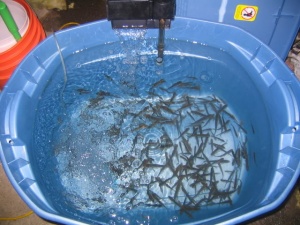 Warmer temperatures are probably not far off and even though winter may not be completely over with, it’s time to go ahead and start planning your strategy. Reservoirs, lakes, ponds and rivers will soon be dotted with boats and the anticipation of plentiful action is in the air. Cabin fever time may be drawing to a close.
Warmer temperatures are probably not far off and even though winter may not be completely over with, it’s time to go ahead and start planning your strategy. Reservoirs, lakes, ponds and rivers will soon be dotted with boats and the anticipation of plentiful action is in the air. Cabin fever time may be drawing to a close.
One of the questions that pop up this time of year is how to best entice the crappie bite. This delectable fish is one of the South’s premier targets and with good reason. If you like to eat fish that have a light flavor, fried crappie filets are at the top of the list. How to get them from the lake to the frying pan is the only remaining question.
Whether you are fishing in reservoirs or ponds, the two most popular methods for taking crappie are with live minnows and small jigs. In both instances there are several ways to present these baits to the fish, but which one consistently catches the most fish? In talking to fishing guides who do this for a living the consensus is that jigs are their first choice. The major reasons the guides favor jigs is that they are more versatile, jigs can provide a wider range of variety, and you can cover more water in a shorter span of time with these lures.
We must lend a great deal of credence to what these gentlemen have to say because if they don’t consistently catch fish, they can’t stay in business.
Jigs can be fished in a variety of ways. Spider-rigging is one of the most popular for the really serious angler. Spider-rigging is a method of arranging a number of rods in rod holders across the bow of your boat so that you can cover a wide area of water with different types and colors of jigs that are at the exact depth you want them. Additionally, by adjusting the speed of your trolling motor you can also fish them at the speed you desire. Once you have determined a pattern the fish seem to like, you can convert all of your poles to a similar style, thus enhancing your chances of putting more meat in the boat.
The guides stress that experimenting with different presentations is the key until you hit on the right combination. Then you simply give them what they want. This method seems to be one of the most effective ways to catch crappie if they are in open water.
 Once crappie head closer to the banks to spawn, however, this method is not workable. The fish are going to be in shallow water and often situated around shoreline cover like stumps, fallen trees, etc. When crappie are in these places a jig with a cork above it could be the ticket. Now, instead of trolling, you will be casting to specific spots where cover is visible or where you know there is underwater brush. A light spinning, or spin-casting outfit is perfect for this scenario. One thing to remember is that the fish are now in shallow water and more easily spooked, so keep your boat as far away as possible from the spots you want to fish. Pull the cork through the area and let the jig fall back down as you work your way through the cover. Some guides recommend using fairly heavy braided line in dense cover so you won’t have to change so many rigs out. Braided line is ultra sensitive to help you feel bites earlier and is strong enough to pull the hook out of snags without breaking. The small wire hooks will bend and come loose and you can straighten the hooks back with a pair of needle-nose pliers.
Once crappie head closer to the banks to spawn, however, this method is not workable. The fish are going to be in shallow water and often situated around shoreline cover like stumps, fallen trees, etc. When crappie are in these places a jig with a cork above it could be the ticket. Now, instead of trolling, you will be casting to specific spots where cover is visible or where you know there is underwater brush. A light spinning, or spin-casting outfit is perfect for this scenario. One thing to remember is that the fish are now in shallow water and more easily spooked, so keep your boat as far away as possible from the spots you want to fish. Pull the cork through the area and let the jig fall back down as you work your way through the cover. Some guides recommend using fairly heavy braided line in dense cover so you won’t have to change so many rigs out. Braided line is ultra sensitive to help you feel bites earlier and is strong enough to pull the hook out of snags without breaking. The small wire hooks will bend and come loose and you can straighten the hooks back with a pair of needle-nose pliers.
 Most of the professionals also have a bunch of minnows with them when taking a party out. They like to have various sizes to choose from in the bucket. To some pros, minnows are the go-to strategy if the bite is slow. Some days the crappie will be less active and on those days will probably be on the deeper brush piles and other cover. A minnow dropped down in these types of areas may get reaction strikes from otherwise disinterested fish. The object is to tantalize or annoy them into biting. Guides have different opinions on how to best hook the minnows. Some prefer to hook them through the back because they think it gives them a better swimming presentation. The downside of this method is that the minnows seem to die more quickly. Other guides like to hook them through the lower lip and then through the nostril to prevent this problem. Typically, many guides use both methods to see which ones the fish prefer. Another point the pros make is to keep a lively bait in the water. Change it out every five or 10 minutes and change baits if you relocate.
Most of the professionals also have a bunch of minnows with them when taking a party out. They like to have various sizes to choose from in the bucket. To some pros, minnows are the go-to strategy if the bite is slow. Some days the crappie will be less active and on those days will probably be on the deeper brush piles and other cover. A minnow dropped down in these types of areas may get reaction strikes from otherwise disinterested fish. The object is to tantalize or annoy them into biting. Guides have different opinions on how to best hook the minnows. Some prefer to hook them through the back because they think it gives them a better swimming presentation. The downside of this method is that the minnows seem to die more quickly. Other guides like to hook them through the lower lip and then through the nostril to prevent this problem. Typically, many guides use both methods to see which ones the fish prefer. Another point the pros make is to keep a lively bait in the water. Change it out every five or 10 minutes and change baits if you relocate.
Lastly there are those who use a combination of both the minnow and jig strategies. Oftentimes tipping a jig with a minnow is just the ticket the fish want on a particular day. Both methods can be successful and if you have questions on more specific information don’t hesitate to send me an email. This is a great time of year to catch crappie and I’m glad to help if I can.
Author: Alvin Richardson